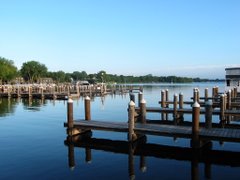The Lake Minnetonka Association is dedicated to the sound environmental management and protection of
Our vision for milfoil management is to expand a long-term comprehensive restoration program throughout the lake.
Milfoil has been managed primarily through the harvesting program of the Lake Minnetonka Conservation District. This program, established in 1989, harvests (or cuts) and removes milfoil in targeted areas around the lake. While the program is managed and administered effectively; there are limitations to what harvesting can accomplish.
Stakeholders from three bays (Carmans, Grays and Phelps) had these views regarding the harvesting program: only 16% of respondents thought the harvesting program was effective and 76% thought it is short-term, small-scale or ineffective. In addition, the number of acres harvested has decreased by 100% since 1989. In 2007, only 323 acres were harvested.
Here is why we think this makes sense:
Herbicides are available that can selectively control milfoil and protect native plants. Compared to harvesting, selective herbicides have these advantages:
- Selective herbicides are safe and a restorative.
- Selective herbicides will actually control milfoil over large areas and for multiple seasons.
- Selective herbicides are applied early in the season and their use will diminish over time.
- There are no capital investments.
- Significant reductions in lakeshore cleanup are expected.
Another significant advantage is that larger areas of milfoil can be controlled within the same budget as is now available for the harvesting program. Our analysis indicates the number of acres of milfoil controlled could increase by five-fold within the same operating budget for the harvesting program. We propose involving lakeshore owners as private funding partners in this program, because they have demonstrated a willingness to help protect this public lake.
Our complete analysis can be found on our web site in a document titled, “LMA Position Statement on Milfoil Management.”
We believe the new thinking we present will help the overall efforts to better protect and manage


1 comment:
Hello. This post is likeable, and your blog is very interesting, congratulations :-). I will add in my blogroll =). If possible gives a last there on my blog, it is about the Aluguel de Computadores, I hope you enjoy. The address is http://aluguel-de-computadores.blogspot.com. A hug.
Post a Comment